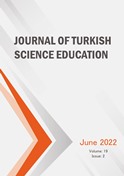Three Levels of Chemical Representation-Integrated and Structured Inquiry-Based Reaction Rate Module: Its Effect on Students’ Mental Models
Keywords:
module, structured inquiry, three levels of chemical representation, mental modelsAbstract
This study aims to determine the effectiveness of the structured inquiry-based reaction rate module that is integrated with three levels of chemical representation in improving students' mental models. The study design was a Randomized Control Group Posttest Only Design and the research subjects were 137 students from two public senior high schools in the city of Padang, Indonesia. The research instruments used were learning achievement test and two-tier diagnostic test. T-test results on the research hypotheses showed that learning outcomes and mental models of students in the experimental class were significantly higher than those of students in the control class at both schools. Thus, the structured inquiry-based reaction rate module developed is effective to be used in the learning process to improve mental models of senior high school students.
Downloads
Downloads
Issue
Section
Published
License
Copyright (c) 2022 Journal of Turkish Science Education

This work is licensed under a Creative Commons Attribution 4.0 International License.
